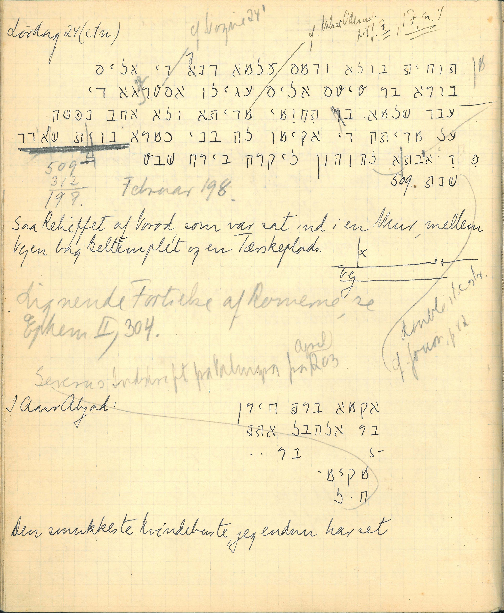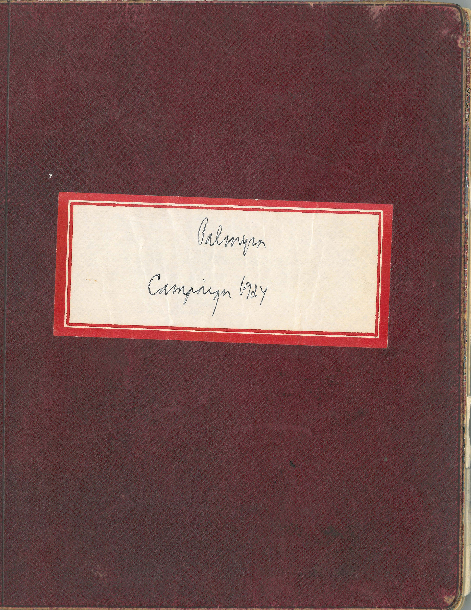Harald Ingholt’s Excavation Diaries from his Fieldwork in Palmyra – an Open Data Online Resource
New publication on Harald Ingholt’s Excavation Diaries by Centre Director Professor Rubina Raja and Postdoc Julia Steding.


The Danish archaeologist Harald Ingholt (1896-1985) conducted fieldwork in the southwest necropolis of Palmyra in the 1920s and 1930s during the French Mandate. The fieldwork diaries stemming from his 1924, 1925, and 1928 campaigns were part of the material he donated to the Ny Carlsberg Glyptotek in 1983. Together with the extensive archive focusing on the portrait-material from Palmyra that recently has been made available as an online resource and soon be published in a commented and updated version (Bobou, Miranda, and Raja forthcoming), the diaries have formed part of the Palmyra Portrait Project (funded by the Carlsberg Foundation) since 2012 and the project Archive Archaeology: Preserving and Sharing Palmyra’s Cultural Heritage through Harald Ingholt’s Digital Archives (funded by the ALIPH Foundation) since 2020.
The diaries and their research potential are highlighted in a new article published in the Journal of Open Archaeology Data:
Raja. R. & Steding, J. (2021). “Harald Ingholt’s Excavation Diaries from his Fieldwork in Palmyra – an Open Data Online Resource”. Journal of Open Archaeology Data
, 9.8: 1-9. DOI: doi.org/10.5334/joad.84.
Unique information about Palmyra – now available as open data
The diaries have been made available as open data, to make available the material to scholars with interest in Palmyra, the Roman Near East, or archival studies. The diaries were digitized within the framework of the Palmyra Portrait Project and saved as sets of .pdf files, each diary as one complete data set, in the repository Figshare (DOI: https://doi.org/10.6084/m9.figshare.c.5442765.v1). Each page was scanned in 1200dpi and can now be used for further research on Palmyra, fieldwork practices, and the recontextualization of archaeological findings as well as considerations on the ongoing discussions about democratization of data and past archaeological practices in regions that then were colonialized by European powers.
They are a unique source of information on the southwest Necropolis of Palmyra, and the daily life on a Near Eastern field project in the early twentieth century. Ingholt documented numerous of his findings in much detail – among these the hypogea and their layouts, inscriptions, sculptures, and decorations. He also noted whenever he bought objects from the local inhabitants, for example, banqueting tesserae or heads from funerary reliefs. Lists of workers and information on scholars who he corresponded with or who visited the excavations give insight into the organization of the work and the social life at and around the excavation. In total, six diaries have been found. One of them served as a draft for diary 1, which focuses on the fieldwork undertaken in 1924. Diary 2 and diary 4 are respectively focusing on the campaigns from 1925 and 1928. Diary 3 holds sketches of all excavated tombs, including information on their direction towards north and their location in the necropolis. This diary was accompanied by a hand-drawn map. Diary 5 is an inventory of all the tombs Ingholt worked in over the years. Ingholt mentioned around 80 tombs throughout the diaries but only published 13 of them over the course of the following decades. On the one hand the diaries provide a splendid foundation to study unpublished graves and their inscriptions and decor; on the other hand, the diaries also allow the reevaluation of the findings published by Ingholt and add new information to already explored contexts.
For the Archive Archaeology project, see https://projects.au.dk/archivearcheology/
For the Palmyra Portrait Project, see https://projects.au.dk/palmyraportrait/
Bibliography and further reading
- Bobou, O., Kristensen, N. B., McAvoy, S., & Raja, R. (2020). “Archive Archaeology in Palmyra, Syria. A new 3D reconstruction of the Tomb of Ḥairan”. Digital Applications in Archaeology and Cultural Heritage. DOI: doi.org/10.1016/j.daach.2020.e00164
- Bobou, O., Miranda, A., and Raja, R. (2021). “The Ingholt Archive. Data from the project, ‘Archive Archaeology: Preserving and Sharing Palmyra’s Cultural Heritage through Harald Ingholt’s Digital Archives’”. Journal of Open Archaeology Data 9.6: 1-10. DOI: http://doi.org/10.5334/joad.78
- Bobou, O. Miranda, A., Raja, R. & Yon, J.-B. (Forthcoming). The Ingholt Archive: The Palmyrene Material, Archive Archaeology. Turnhout.
- Raja, R. & Sørensen, A. H. (2015). Harald Ingholt & Palmyra, Aarhus.
- Raja, R. & Sørensen, A. H. (2015). "The “Beauty of Palmyra” and Qasr Abjad (Palmyra): New discoveries in the archive of Harald Ingholt", Journal of Roman Archaeology 28.1: 439-450.
- Raja, R. (2019). The Palmyra Collection: Ny Carlsberg Glyptotek. Copenhagen.
- Raja. R. & Steding, J. (2021). “Harald Ingholt’s Excavation Diaries from his Fieldwork in Palmyra – an Open Data Online Resource”. Journal of Open Archaeology Data, 9.8: 1-9. DOI: https://doi.org/10.5334/joad.84
- Raja, R., Steding, J. & Yon, J.-B. (eds.) (2021). Excavating Palmyra. Harald Ingholt’s Excavation Diaries: A Transcript, Translation, and Commentary, Studies in Palmyrene Archaeology and History 4, 2 vols. Turnhout.
